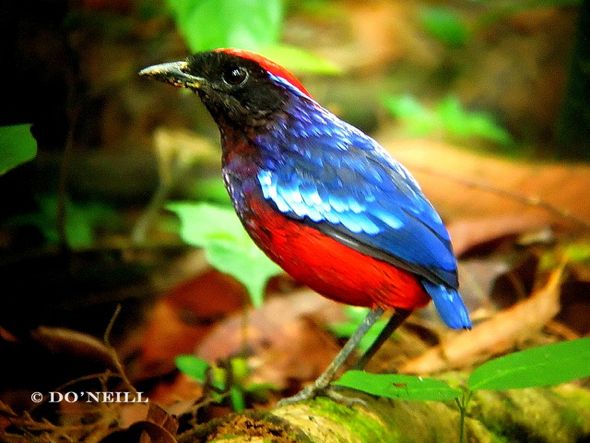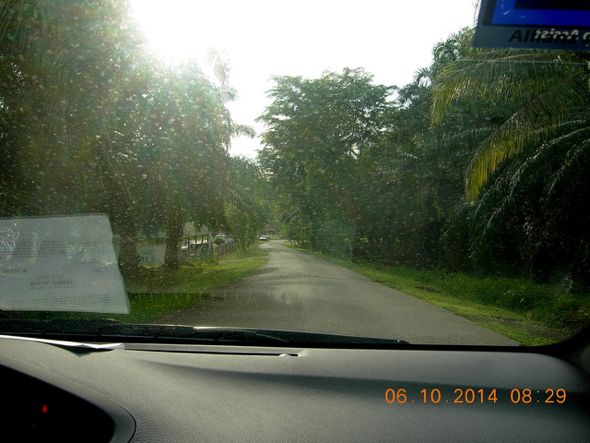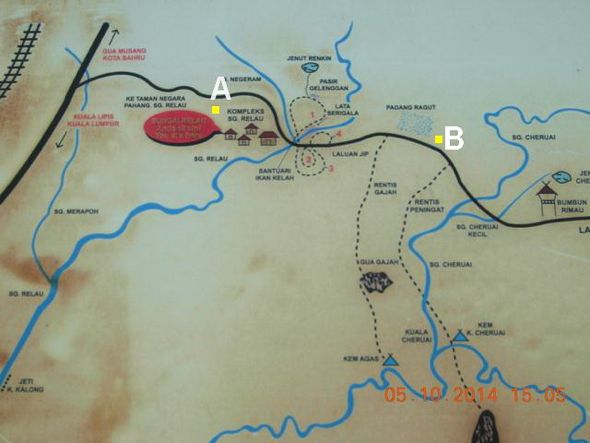“To encounter Pittidae species in visiting primary forests of Peninsular Malaysia has to be one of any bird-photographers’ highlights (above).
“A revisit to Taman Negara late 2014, after an absence of five years, justified a comparison of differences in its faunal population and ecological habitats. It was no good news for ornithology and conservation.
“Relau River that flows and dissects the Park has deteriorated in water quality, resulting in complaints of plummeted numbers of fish species.
“Rows of cultivated oil palms in plantations are allowed growth right up to gate entrance of north-west sector of National Park, Merapoh. (Co-ordinates: 4.680611Lat/102.056333Long) (above, below).
“Continuous maintenance by usage of pesticides/fertilizers –residues they leave behind or flow into river course bring no mortal justice to fauna, especially birds that drink from it.
“Bird count plummeted from an impressive list of 240 – data extracted from bird-i-witness LINK.
“I struggled to reach fewer than 100 species over a 10 days’ visit. I limited my birding observation area to between A and B (above).
“Another contributing factor in bird population loss over the last decade cannot be denied further. A decade of bad practices by errant bird-photographers has reared its ugly, hydra head. The irresponsible and prolonged usage of hard flash photography on nestlings and prevailing practice of excessive bird calls playback recordings had taken its toll.
“My past advocacy to avoid hard flash photography is showing signs of a plateau off amidst many protests and raised eyebrows in the past. These days I can report, new generation of bird-photographers are becoming more aware of such unsound practices, more knowledgeable with their ever evolving camera lens and hopefully, more intelligent use of their sophisticated gears, in a more bird user friendly manner.
“As member of Oriental Bird Cub (OBC), it gives me this opportunity to re-address the issue of advocating good practices in bird-photography; especially on the detrimental and excessive usage of playback recordings, as inspired by a paragraph written by in-coming Chairman Mike Edgecombe of OBC in his first letter address.
“With permission granted, here is paragraph as written on page 3, fifth paragraph of Birding Asia (Number 21 June 2014) for non-member readers. (For membership support, Email: [email protected])
“But I am also seeing situations where pressures from the increased interest are having a detrimental effect. Inevitably, often this increase in pressure falls on those species which are amongst the most rare and vulnerable. Two frequent complaints that seemed all too common today involve the overuse of tape playback and pressure by photographers at nesting sites. I know from my own experience that it is easy to get carried away in the excitement of seeing a bird for the first time; getting video footage or a stunning photograph adds to the joy and our lasting memories, but we have a responsibility and we are no longer likely to be the ones enjoying that particular experience. I know that the vast majority of nature watchers demonstrate restraint and a sensible careful approach and we should not hesitate to encourage others to adopt the same”.
“This paragraph letter above inspired me to begin my first article for 2015 – my 155th contribution to Bird Ecology of Singapore Group (BESG), to report the behaviour of Garnet Pitta (Pitta granatina) in response to continuous playback recordings executed by visiting bird-photographers.
“Join me in Part 2 for a walk into the forest trail of Taman Negara, Peninsular Malaysia to seek this ground jewel out, to observe and monitor both bird-photographers and bird if they ‘tango’ in this rare footage in photography… (above).
Avian Writer Daisy O’Neill, Penang, Malaysia
and
Mike Edgecombe, UK
6th March 2015
Copyright article and all copy bird images – Courtesy of Daisy O’Neill Bird Conservation Fund
Ref: Birding Asia Number 21 June 2014













